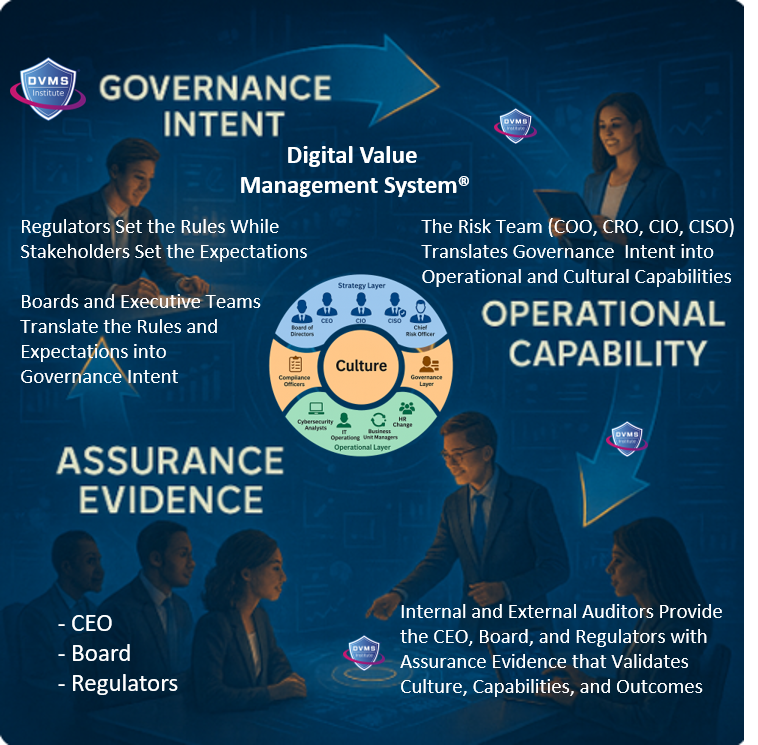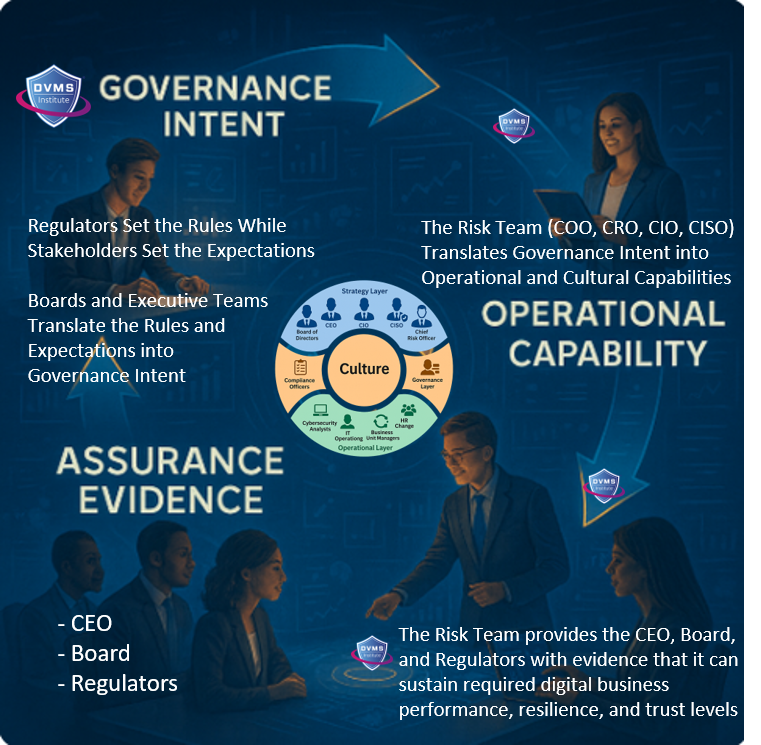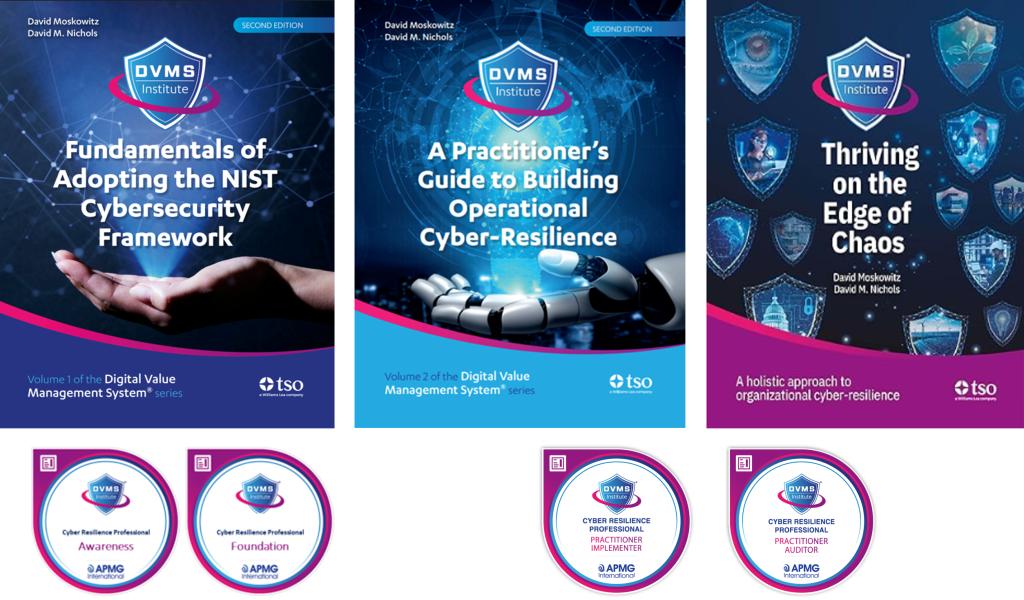How Culture Powers the People who Drive the Strategy, Governance, and Operational Layers of a DVMS Cyber Operational Resilience Program
Rick Lemieux – Co-Founder and Chief Product Officer of the DVMS Institute
Delivering cyber operational resilience in a modern Digital Value Management System (DVMS) environment requires far more than frameworks, controls, or technologies. It demands a deeply embedded cultural foundation that shapes how people think, behave, and make decisions across the strategy, governance, and operations layers of the enterprise.
While the DVMS provides the structure—linking Governance Intent, Operational Capability, and Assurance Evidence—culture drives the energy and alignment that makes this structure work in practice. Without the right cultural environment, even the strongest cybersecurity strategies fail to translate into consistent action, and the most advanced technologies cannot compensate for fragmented collaboration, weak accountability, or poor decision-making. Ultimately, culture is what powers the DVMS and enables organizations to achieve measurable, high-performing, and resilient digital outcomes.
Culture at the Strategic Layer: Shaping Intent, Priorities, and Accountability
At the strategic layer of a DVMS Cyber Operational Resilience program, culture determines whether cybersecurity is treated as a business enabler or as a technical afterthought. Executives and boards set the tone for how cybersecurity integrates into the organization’s strategic mission—defining not only what the organization intends to achieve but how people at every level are expected to behave as they create, protect, and deliver digital value. This cultural stance influences risk appetite, investment decisions, and the degree to which cybersecurity is integrated into strategic planning, rather than being added as an afterthought.
A culture that prioritizes transparency, accountability, and cross-functional collaboration strengthens the strategic effectiveness of the DVMS. For example, when executive leadership consistently communicates that digital trust, resilience, and value protection are fundamental to business success, it creates alignment between business strategy and cyber strategy. This cultural clarity enables CEOs, boards, CISOs, and CROs to work together in defining strategy-risk profiles, shaping Governance Intent, and ensuring strategic direction is grounded in realistic assessments of digital risk.
If culture does not support open dialogue about risk, strategic blind spots form. Teams may under-report vulnerabilities, avoid escalating concerns, or misalign operational realities with executive expectations. The DVMS depends on accurate, evidence-based decision-making, and this is only possible in a culture where truth flows upward without fear. Thus, culture becomes the force that allows strategy to become actionable, risk-aware, and aligned with organizational intent.
Culture at the Governance Layer: Enabling Structure, Oversight, and Assurance
The governance layer translates strategic direction into the policies, standards, structures, and oversight mechanisms that operational teams follow. But governance can only function effectively if culture supports the behaviors required to implement and enforce these structures.
Culture influences how seriously people take governance requirements, how consistently they adhere to policies, and how willingly they participate in assurance activities. A strong culture of integrity, responsibility, and continuous improvement empowers governance leaders—governance officers, compliance professionals, legal counsel, internal audit, and data governance teams—to fulfill their roles effectively. It enables them to establish governance frameworks that are not only documented but also lived.
In a DVMS context, the governance layer relies on cultural attributes such as:
- Respect for process: Stakeholders understand why governance exists and embrace it as essential to value creation and protection.
- Shared responsibility: Teams see governance as a collective obligation, not the job of one department.
- Evidence-driven behavior: People value metrics, assurance evidence, and fact-based decision-making.
- Adaptability: Policies can evolve because the culture supports learning and change.
Where culture is weak, governance becomes performative. People may comply on paper but bypass controls in practice. Assurance evidence becomes superficial, and executives cannot rely on the information they receive. This undermines the DVMS model, where assurance mechanisms are central to verifying that expected outcomes are being achieved.
Conversely, when culture supports governance excellence, the DVMS thrives. Everyone understands their part in the GRAA (Governance, Resilience, Assurance, and Accountability) system, and governance shifts from a compliance burden to a value-enabling capability. This alignment ensures that policies reflect reality, assurance activities provide honest insights, and governance evolves with the business rather than lagging it.
Culture at the Operational Layer: Driving Behavior, Execution, and Resilience
The operational layer is where cyber resilience is truly tested—where analysts monitor networks, engineers build secure architectures, managers make day-to-day risk decisions, and employees at every level play a role in protecting digital assets. In this layer, culture directly influences the outcomes the DVMS aims to achieve because it shapes how individuals behave when no one is watching.
Effective operational resilience depends on cultural characteristics such as:
- Proactive decision-making: Teams identify and address risks before they become incidents.
- Psychological safety: Employees feel comfortable reporting concerns, mistakes, or emerging threats.
- Shared vigilance: Everyone understands they have a role in cybersecurity—not just the technical teams.
- Continuous learning: Operational teams embrace change, adopt new best practices, and innovate solutions.
- Cross-functional teamwork: Silos break down, allowing cybersecurity to integrate into operations, development, risk, and business processes.
In organizations where culture supports these behaviors, the DVMS operational layer becomes a high-performance engine. The MVC Model’s capabilities—Design, Execute, Change, and Innovate—come to life as people naturally adopt resilient practices and seek opportunities to improve systems. Assurance evidence improves because frontline teams are aligned with governance and willingly contribute to transparent reporting. Incidents decrease, response times improve, and operational resilience becomes a competitive advantage.
Without the right culture, however, operations falter. Teams may ignore procedures, delay reporting issues, or resist changes needed to strengthen security. Even strong technical controls become ineffective when everyday behaviors do not reinforce them.
Culture as the Core Enabler of the DVMS System
Across all layers—strategy, governance, and operations—culture serves as the unifying force that transforms the DVMS into a functioning cyber operational resilience management system. It:
- Aligns people to Governance Intent
- Strengthens operational capability
- Ensures the accuracy of assurance evidence
- Enables resilience, adaptability, and continuous improvement
- Promotes accountability and trust
- Transforms cybersecurity from a siloed function into a shared responsibility
The DVMS defines the architecture for Cyber Operational Resilience, but culture is the energy that powers that architecture. It ensures that roles align, processes function, evidence is reliable, and digital value is created, protected, and delivered as intended. In an environment of accelerating digital transformation, evolving cyber threats, and increasing regulatory demands, culture becomes the ultimate determinant of whether a DVMS succeeds or fails.
Conclusion
Culture is not an add-on to the DVMS—it is the foundation that enables the entire system to function. It drives the behaviors that sustain governance, energizes the practices that support operational resilience, and informs the mindset that shapes executive strategy. Without the right culture, organizations cannot achieve the measurable, resilient, and high-performing digital outcomes the DVMS is designed to deliver. However, with an intense, adaptive, and aligned culture, the DVMS becomes a powerful force for digital value creation and protection, enabling organizations to thrive in an increasingly complex digital world.
About the Author

Rick Lemieux
Co-Founder and Chief Product Officer of the DVMS Institute
Rick has 40+ years of passion and experience creating solutions to give organizations a competitive edge in their service markets. In 2015, Rick was identified as one of the top five IT Entrepreneurs in the State of Rhode Island by the TECH 10 awards for developing innovative training and mentoring solutions for boards, senior executives, and operational stakeholders.
Digital Value Management System® (DVMS)
Digital Value Management System® (DVMS)
An Adaptive, Culture-Driven Governance, Resilience, Assurance, and Accountability (GRAA) System
A Digital Value Management System (DVMS) enables organizations of any size or complexity to operate with an adaptive, culture-driven Governance, Resilience, Assurance, and Accountability (GRAA) system that ensures Cybersecurity, GRC, ITSM, and AI programs consistently deliver the outcomes expected by boards, executive leaders, and government regulators—even under stress.
Through a structured, intelligence-driven integration of Governance Intent, Operational Capability, and Assurance Evidence, the DVMS provides executive leadership and auditors with explicit confirmation that digital transformation initiatives are delivering their intended outcomes.
Through its MVC, CPD, 3D Knowledge, and FastTrack Models, the DVMS operationalizes a:
- Governance Overlay system that unifies strategy, assurance, and operations
- Behavioral Engine that transforms how organizations think, decide, and act in uncertainty
- Learning System that measures, adapts, and innovates culture over time.

DVMS White Papers
- The Assurance Mandate – Moving to Evidence-Based Operational Resilience
- Assurance in Action – Turning Policy into Organizational Capability
- Governance By Assurance – A Systems Approach to Outcome-Based Regulation
DVMS Organizational Benefits
Instead of replacing existing operational frameworks, the DVMS elevates them—connecting and contextualizing their data into actionable intelligence that validates performance and exposes the reasons behind unmet outcomes.
By adopting a DVMS, organizations are positioned to:
- Maintain Operational Stability Amidst Constant Digital Disruption
- Deliver Digital Value and Trust Across A Digital Ecosystem
- Satisfy Critical Regulatory and Certification Requirements
- Leverage Cyber Resilience as a Competitive Advantage
DVMS Leadership Benefits
- For the CEO, the DVMS provides a clear line of sight between digital operations, business performance, and strategic outcomes—turning governance and resilience into enablers of growth and innovation rather than cost centers.
- For the Board of Directors, the DVMS provides ongoing assurance that the organization’s digital assets, operations, and ecosystem are governed, protected, and resilient—supported by evidence-based reporting that directly links operational integrity to enterprise value and stakeholder trust.
- For the CIO, CRO, CISO, and Auditors: an integrated, adaptive, and culture-driven governance and assurance management system that enhances digital business performance, resilience, trust, and accountability
DVMS Institute Certified Training Programs
DVMS Cyber Resilience Awareness Training
The DVMS Cyber Resilience Awareness training teaches all employees the fundamentals of digital business, its associated risks, the NISTCSF, and their role as part of a culture responsible for protecting digital business performance, resilience, and trust. This investment fosters a culture that is prepared to transform systemic cyber risks into operational resilience.
DVMS NISTCSF Foundation Certification Training
The DVMS NISTCSF Foundation certification training course teaches ITSM, GRC, Cybersecurity, and Business professionals a detailed understanding of the NIST Cybersecurity Framework and its role in an integrated, adaptive, and culture-driven governance and assurance management system that drives digital business performance, resilience, trust, and accountability.
DVMS Cyber Resilience Practitioner Certification Training
The DVMS Practitioner certification training course teaches ITSM, GRC, Cybersecurity, and Business professionals how to assess, design, implement, operationalize, and continually innovate a Digital Value Management System® program that integrates fragmented frameworks such as NIST, ITSM, and GRC into an adaptive and culture-driven governance and assurance system that enhances digital business performance, resilience, trust, and accountability.
DVMS Brochures
DVMS Explainer Videos
- Architecture Video: David Moskowitz explains the DVMS System
- Case Study Video: Dr. Joseph Baugh Shares His DVMS Story.
- Overlay Model – What is an Overlay Model
- MVC ZX Model – Powers the CPD
- CPD Model – Powers DVMS Operations
- 3D Knowledge Model – Powers the DVMS Culture
- FastTrack Model – Enables A Phased DVMS Adoption
Digital Value Management System® is a registered trademark of the DVMS Institute LLC.
® DVMS Institute 2025 All Rights Reserved



